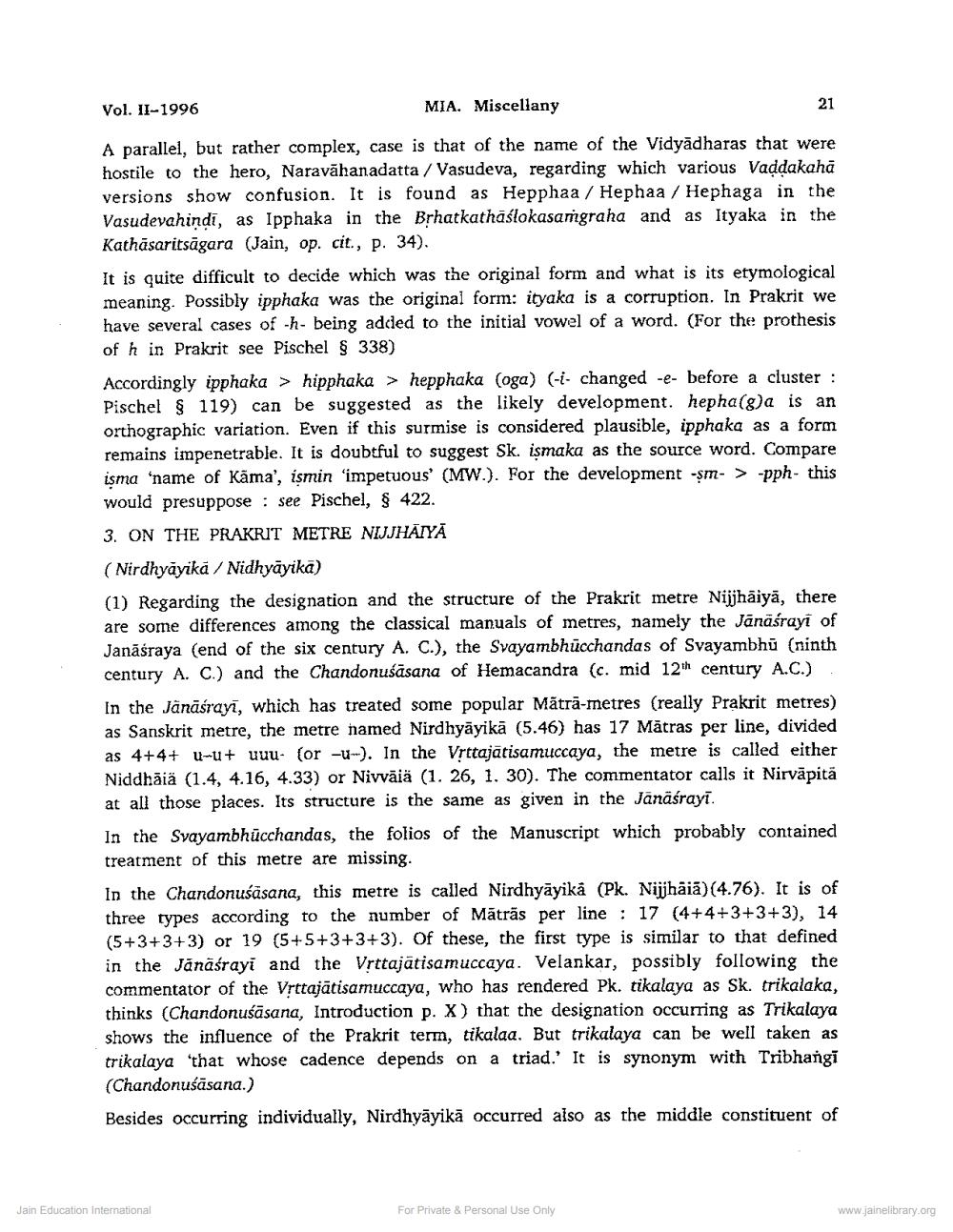Book Title: MIA Miscellany Author(s): H C Bhayani Publisher: Z_Nirgrantha_1_022701.pdf and Nirgrantha_2_022702.pdf and Nirgrantha_3_022703.pdf View full book textPage 4
________________ Vol. 11-1996 MIA. Miscellany 21 A parallel, but rather complex, case is that of the name of the Vidyādharas that were hostile to the hero, Naravāhanadatta / Vasudeva, regarding which various Vaddakahā versions show confusion. It is found as Hepphaa/Hephaa/Hephaga in the Vasudevahindi, as Ipphaka in the Brhatkathāślokasangraha and as Ityaka in the Kathāsaritsāgara (Jain, op. cit., p. 34). It is quite difficult to decide which was the original form and what is its etymological meaning. Possibly ipphaka was the original form: ityaka is a corruption. In Prakrit we have several cases of -h- being added to the initial vowel of a word. (For the prothesis of h in Prakrit see Pischel § 338) Accordingly ipphaka > hipphaka >> hepphaka (oga) (-i- changed -e- before a cluster : Pischel § 119) can be suggested as the likely development. hepha(g)a is an orthographic variation. Even if this surmise is considered plausible, ipphaka as a form remains impenetrable. It is doubtful to suggest Sk. işmaka as the source word. Compare isma 'name of Kāma', ismin 'impetuous' (MW.). For the development -$m- > -pph- this would presuppose : see Pischel, § 422. 3. ON THE PRAKRIT METRE NIJJHÄIYÄ (Nirdhyāyikā / Nidhyāyika) (1) Regarding the designation and the structure of the Prakrit metre Nijjhāiyā, there are some differences among the classical manuals of metres, namely the Jānāšrayi of Janāśraya (end of the six century A. C.), the Svayambhūcchandas of Svayambhū (ninth century A. C.) and the Chandonuśāsana of Hemacandra (c. mid 12th century A.C.). In the Jānāšrayı, which has treated some popular Mātrā-metres (really Prakrit metres) as Sanskrit metre, the metre named Nirdhyāyikā (5.46) has 17 Mātras per line, divided as 4+4+ u-u+ uuu- (or -u-). In the Vrttajātisamuccaya, the metre is called either Niddhāiä (1.4, 4.16, 4.33) or Nivvāiä (1. 26, 1. 30). The commentator calls it Nirvāpitä at all those places. Its structure is the same as given in the Jānāśrayi. In the Svayambhūcchandas, the folios of the Manuscript which probably contained treatment of this metre are missing. In the Chandonusasana, this metre is called Nirdhyāyikå (Pk. Nijjhāiā) (4.76). It is of three types according to the number of Mātrās per line : 17 (4+4+3+3+3), 14 (5+3+3+3) or 19 (5+5+3+3+3). Of these, the first type is similar to that defined in the Jānāśrayi and the Vrttajātisamuccaya. Velankar, possibly following the commentator of the Vrttajātisamuccaya, who has rendered Pk. tikalaya as Sk. trikalaka, thinks (Chandonusāsana, Introduction p. X) that the designation occurring as Trikalaya shows the influence of the Prakrit term, tikalaa. But trikalaya can be well taken as trikalaya 'that whose cadence depends on a triad.' It is synonym with Tribhangi (Chandonuśāsana.) Besides occurring individually, Nirdhyāyikā occurred also as the middle constituent of Jain Education International For Private & Personal Use Only www.jainelibrary.orgPage Navigation
1 2 3 4 5 6 7 8
